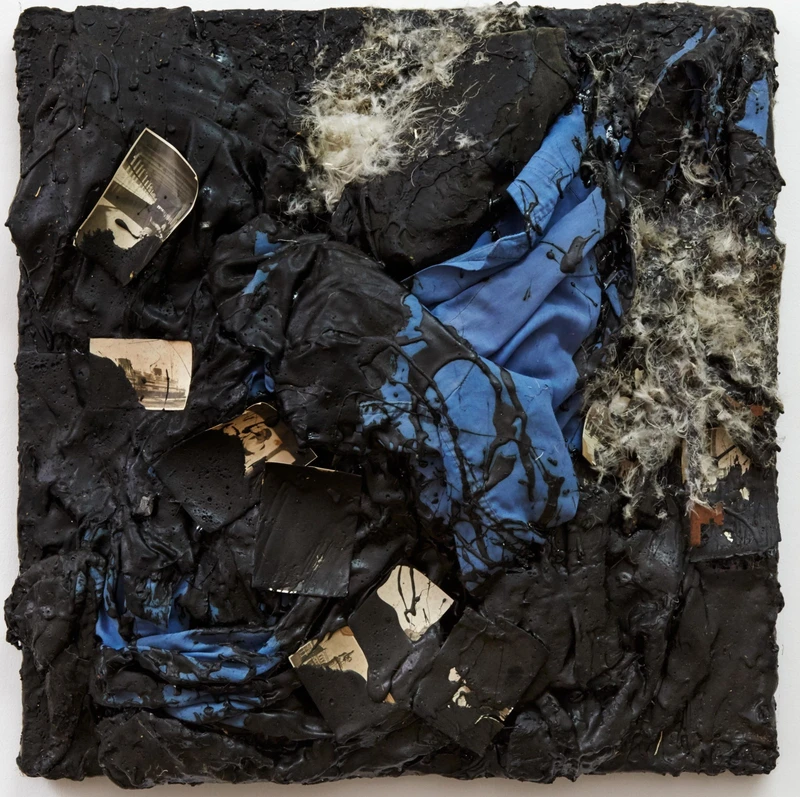Derek Jarman: The Black Paintings : A Chronology, Part II 1988 - 1991
16 Jul-20 Sep 2025


Back here this the evening I walked along the seashore. The tide was far out on the horizon and the water on the sand reflected the faded rose of the sunset like a mirror; for a brief moment the sun lit up the boats and houses around the bay before suddenly disappearing.
Derek Jarman,
Modern Nature, Wednesday 22 February 1989
Part II of Derek Jarman The Black Paintings : A Chronology presents works made between 1988 – 1991. During this time Jarman created his garden at Prospect Cottage, wrote his famous diary Modern Nature and made what is thought to be one of his most significant films The Garden, 1990, shot on location in Dungeness.
The diary entries in Modern Nature speak of the joy that Jarman found observing the landscape of Dungeness as well as the creative challenge of making a garden around Prospect Cottage. He found both pursuits healing, following his HIV diagnosis, and as markers of the time during which he lost many friends to the virus. Poetic passages about particular plants and the gradual development of the garden are interlaced with notations about his parallel life in London’s Soho with HB and reminiscences about other gardens he had access to a s a child. Jarman called Modern Nature a form of self-archaeology, an ‘archaeology of the soul.’ The notion of memory is also central to the black paintings from this period, as old photographs are crystalised on their black surfaces. Self-reflection is also present in both references to and the use of mirrors, notably in paintings during 1988, onto which he placed small objects gathered from the beach, often gilded and transformed, alluding to alchemic symbols.
The iconography in paintings from this period relates directly to the theme of his film The Garden – the depiction of Christ as a persecuted figure analogous to the persecution Jarman and his community felt at the time, especially following the introduction of Clause 28 in 1988 (legislation that banned the ‘promotion of homosexuality’).The cross appears in several of the paintings, embedded in the paint and surrounded by toy figures of demons, or as a cross made of thorns alongside a thermometer, implying the threat of AIDS.
In 1989, assisted by the filmmaker David Lewis, Jarman discovered a new painting technique using tar:
David arrived at lunch with an enormous block of pitch.
After swimming we built a brick hearth, lit a bonfire, and melted the pitch in an old tin can. For an hour we rushed back and forth to the house for brushes, gloves, barbed wire, crucifixes, prayer books, bullets, a model fighter plane even an old telephone, which we tarred and feathered. The results were instant and extraordinary. The hot tar splashed everywhere and set like shining jet; the half-buried crucifix looked like a Medardo Rosso sculpture.
Working with the tar had all the excitement of building sand-and-water pinnacles and spires on the beach as a child.
Derek Jarman, Modern Nature, Tuesday 25 July 1989
The enthusiasm for this medium resulted in several paintings made with tar over the next two years. The process itself involved the building of a bonfire on the beach, an appealing aspect to Jarman given his interest in the ancient Greek philosopher Heraclitus who invoked fire as a metaphor for ever-changing life. In one of the tar paintings Jarman quoted words from the philosopher in the form of a street warning sign, a device used in several of the paintings from this period ‘Death is all things we see awake; all we see asleep is sleep". The powerful tar-and-feather scene in The Garden was also an inspiration for these paintings, many of which feature feathers from an old pillow alongside the other objects embedded in the surface.
The Black Paintings in all their multilayered forms provide a monochromatic window into the creative world of Derek Jarman and trace the many themes, ideas and formal strategies that he embarked upon during these years. They precede another great monochrome, the film Blue, 1994, a masterpiece and his final work.
With thanks to the Keith Collins Will Trust
This exhibition also marks the 5 year anniversary of the sale of Prospect Cottage to the nation following a monumental fund raising initiative led by The Art Fund and the generous donations by many people. This has allowed Prospect Cottage to be active and used for residencies by artists, writers, filmmakers, gardeners and academics. The Creative Folkstone website provides further information.